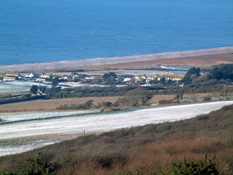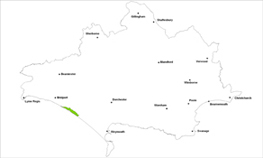Coastal grassland


Location
The Coastal Grassland type is found in one location in Dorset, between Burton Bradstock and Abbotsbury along the Bexington coastline.
Key Characteristics
- exposed, largely treeless and windswept landscape with open, dramatic views along the coast.
- sloping and gently undulating rough coastal limestone grassland and scrub.
- enclosed and defined by the chalk escarpment to the north.
- patchwork of regular fields and low and stunted hedges.
- unsettled with the occasional farmstead and some remaining strip fields.
- steeper slopes closer to the escarpment with grazed pastures and scrub.
- lower slopes nearer the beach contain reeds and grazing marsh.
Coastal grasslands, as a habitat, are found along much of the immediate coastline but it only becomes a landscape type where the characteristic coarse grasses, exposed by the full force of the coast, are backed by the southern escarpment and divide it from the inland landscapes. Due to the lack of trees, smooth landform and since the escarpment prevents views inland; a very strong link with the coast is created enabling panoramic views along the curve of Chesil Beach to Portland and beyond. It is a characterised by south facing undulating chalk and limestone slopes of homogenous rough grasslands, patches of scrub with stunted hedgerows and the occasional windswept tree. It is an area of rough grazing with a gradual transition from scrubby longer grassland and some reedbed near the beach, to shorter grass on the steeper slopes inland. Small grazed regular strip fields often have wire fencing as boundaries due the lack of hedgerows. A lack of development, the sweeping panoramic coastal views and exposed character underpin the natural appearance of this narrow and confined type. West Bexington is the only settlement in the area with its distinctive linear pattern and exposed beach car park. There are occasional farmsteads scattered across the undeveloped area.
Management Objectives
The overall management objective for the Coastal Grassland Landscape Type should be to conserve the open and undeveloped coastal character whilst enhance the characteristic features of rough coastal grasslands, patches of scrub and reeds. Reduce the impact of visitor based development.
Key land management guidance notes
- encourage low impact grazing along the coast and inland ridges to reduce scrub encroachment on important grasslands.
- conserve the pattern of stunted hedgerows, maintaining a balance between post and wire fencing in more open areas.
- protect and enhance the management of reed beds for nature conservation.
- woodland planting is not an objective for the area, but the development of scrub may be acceptable as it forms an important coastal feature, and can be managed as a successional habitat.
- protect watercourses and associated wildlife from soil erosion and the effects of diffuse pollution in the Fleet.
- protect the surviving pattern of strip fields.
- identify, protect and conserve the sweeping views of the coast and in particular of the Fleet, Chesil Beach and Portland e.g. via Parish Action Plans, Village Design Statements and other Settlement Appraisals.
- reduce the impact of car parks and other visitor based development e.g. through sensitive signage and improved management of built features such as walls.
- conserve and enhance the open character of coastal roads e.g. by the careful consideration of new development design, positioning and height.
- identify, conserve and enhance characteristic fingerposts and street/road furniture.
